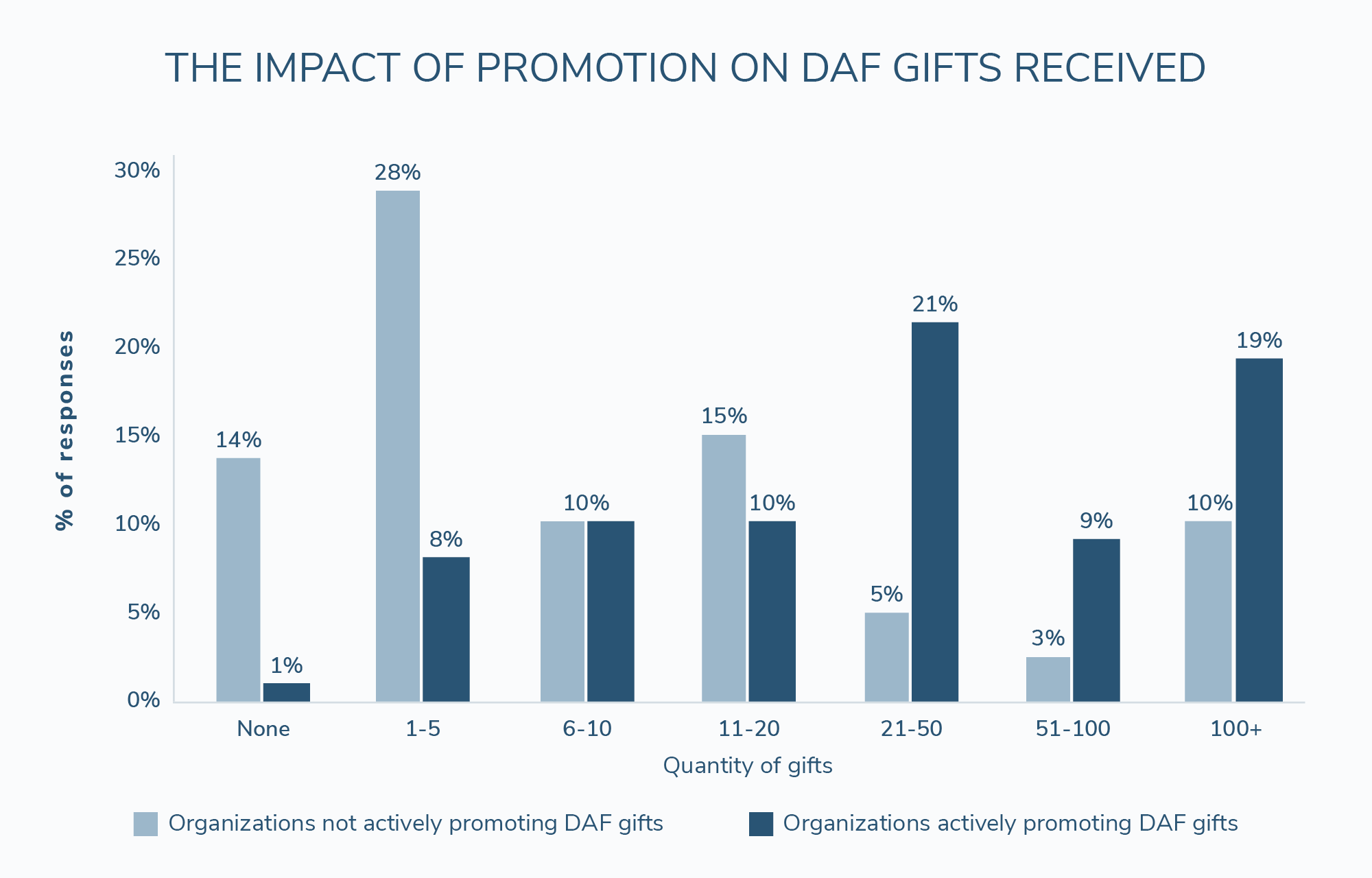How and Why Nonprofits Should Reduce Anonymous DAF Donations

This article was provided by FreeWill.
If you’re a new nonprofit or simply new to DAF grants, think of them as charitable savings accounts where donors can deposit money or assets (like stocks). The sponsoring organization invests the contributions, and later, donors can advise where and when the donations should go.
Donor-advised funds (DAFs) streamline giving, enable strategic generosity, and offer tax advantages to donors. But for nonprofits, there’s a recurring blind spot: anonymous DAF donations.
According to The National Study on Donor-Advised Funds, anonymous DAF grants account for 9% of all DAF grant dollars. That means a significant share of funding may arrive without names, stories, or the opportunity to say “thank you.” The 2025 FreeWill Donor-Advised Fund Report also found that 27% of fundraisers report receiving too many anonymous DAF donations, creating ongoing challenges with fundraising.
In this article, we’ll explore why anonymous DAF gifts happen, their impact, and—most importantly—how your nonprofit can respectfully reduce anonymity to build stronger relationships.
While some donors choose anonymity for personal reasons, others may not even realize they’re invisible to the nonprofits they support. Understanding why DAF gifts arrive without donor details is your first step in addressing the issue.
Many anonymous DAF donations stem from a desire for a low-touch giving experience. They want to give without opening the door to follow-up emails, phone calls, or additional solicitation requests. This preference can make it harder for your nonprofit to identify and pursue major and planned giving opportunities.
Sometimes, donors choose to remain anonymous because they don’t understand what it entails. They might believe the charity still receives their information but just won’t publicize the donation.
Anonymity can also shield a donor from public scrutiny. It allows donors to keep their wealth private, which is especially desirable in an era when major gifts can attract unwanted attention. In other cases, donors may support controversial causes. Staying anonymous offers protection from the judgment of their friends, family, or communities. This also keeps the focus on the cause, not the contributor.
Sometimes, anonymity is the path of least resistance. Many DAF platforms make it easy to select anonymity. They may even default to partial or full anonymity without clearly explaining the implications.
In The National Survey of Donor Advised Fund Managers, here’s what DAF sponsors indicated their platforms’ default anonymity options were:
- 36% full contact information
- 35% partially anonymous, only showing the account name
- 24% account name and donor name (no contact information)
- 1% completely anonymous
- 5% other
In other words, just over one-third of platforms automatically provide full donor information to nonprofits.
Anonymous donations can hinder meaningful relationship-building, data-driven planning, and mission growth. While you should always respect a donor’s choice, encourage more transparency wherever possible.
Reducing anonymous gifts isn’t about control—it’s about connection. When you know who your donors are, you can thank them properly and strengthen their connection to your work. As those relationships grow, so does your organization’s long-term impact. You can also plan more effectively, maintain cleaner records, and highlight generosity to motivate others.
Let’s take a closer look at why reducing anonymity matters:
Identifying DAF donors opens the door to meaningful stewardship, which is the foundation for repeat giving. FreeWill’s DAF giving guide recommends different strategies to engage these supporters. When you know who your donors are, you can:
- Send personalized thank-yous to show the positive, specific impact of their support.
- Invite donors to events, from large public gatherings to private gratitude events.
- Promote interesting volunteer opportunities that reflect their interests.
- Ask them to provide input on special projects to deepen their sense of investment.
These actions help donors feel seen and connected to your mission. From there, you can build trust and invite donors to consider additional gifts. However, none of this is possible if you don’t know who your donors are.
Anonymous donations complicate internal recordkeeping and external reporting. They make it harder to connect donations to donor records and report on contributions when needed.
Plus, if you apply for grants, some funders may ask for details about your donor base. Having accurate, complete records makes it easier to meet those requirements. By identifying more of your DAF donors, you’ll build a cleaner, more accountable fundraising infrastructure—one that supports credibility and legal compliance.
Knowing who your DAF donors are allows your development team to better assess individuals’ giving capacity and predict their future gifts. When giving patterns are tied to actual individuals, you can plan more effectively for campaign pipelines, year-end appeals, and long-term revenue goals.
Reducing anonymous gifts transforms generic data into actionable insights, enabling more intentional, targeted fundraising efforts.
Recognition has a ripple effect. When you publicly acknowledge donors, it inspires others to follow their lead. For example, you might:
- Create a donor wall that features the DAF donors who’ve given above a certain threshold.
- List your DAF donors in your annual report and impact reports.
- Celebrate recent DAF gifts at public events like your galas or luncheons.
- Highlight a donor story on your blog or social media to showcase the motivations behind giving and explain the process.
Anonymous donations are quiet gifts in a world where loud generosity is often more impactful. That said, privacy still matters. Some donors prefer to stay behind the scenes, so always ask for permission before recognizing anyone publicly.
By making a few small changes to how you communicate and receive DAF gifts, you can increase transparency without compromising donor choice. Here are practical ways to encourage more visible giving:
When you receive an anonymous gift, you may still have one line of communication: the sponsoring organization. Send a thank-you letter or email to the DAF provider and ask them to pass it along to the donor. Not all sponsors will do this, but smaller sponsors and community foundations might.
Personalizing this letter might be challenging, but one thing you can do is hone in on their donation’s impact. eCardWidget’s donor thank-you letter guide explains that you should use donor-centric language, emphasizing their role in your nonprofit’s success. Examples the guide suggests include:
- “Because of you…”
- “Your generosity has transformed the lives of…”
- “Your commitment has directly impacted…”
- “Because you cared, we achieved…”
- “Your belief in our mission has enabled…”
Mention tangible goals and outcomes that their gift will or has already helped you achieve. Even when you don’t know their name, this tells the donor that you noticed their support.
It’s also an opportunity to include a gentle message like, “If you’d like to hear more about the impact of your gift, we’d love to connect.” That simple nudge can encourage the donor to self-identify.
Just because you don’t know who a donor is doesn’t mean they aren’t watching. Anonymous donors may still visit your website, open your emails, or attend your events. Treat every piece of your nonprofit’s outreach like it will reach them.
Share impact stories, express gratitude, and make it easy for donors to step forward when they’re ready. Assume they are receiving your communications and make the most of it.
The way you market DAF gifts is an important part of receiving them. In fact, research shows that organizations that actively promote DAF gifts receive more of these gifts:

For organizations that actively ask for DAF gifts and raise over $10 million in individual contributions annually, 77% receive at least one, while 19% receive over 100. Meanwhile, 42% of organizations that raise between $1 million and $10 million annually that don’t ask for DAF gifts report receiving five or fewer gifts. The organizations with these revenue ranges represent the groups most likely to receive DAF gifts.
Remember, many donors choose to remain anonymous without realizing how it affects your ability to thank or contact them. Whenever you mention DAF giving, include a simple explanation of why you’d like to know who they are. That might include a message on your “Ways to Give” page, fundraising campaign materials, or newsletter.
Explain that checking the anonymity box may prevent your organization from receiving their name or contact information, and that you’d love the chance to report back on their gift’s impact. Try not to pressure donors, because some may still want to remain anonymous even after learning the implications. You wouldn’t want to break donor trust or any rules surrounding anonymity.
One of the simplest ways to reduce anonymous DAF gifts is to guide donors through a giving experience that makes sharing their information easy.
Consider embedding a DAF giving tool into key pages of your nonprofit’s website, such as your donation page or Ways to Give page. This helps you collect the necessary information, such as donors’ names, contact information, and gift designations. By using a platform like this, you accomplish two important things:
- You reduce friction, making the act of giving smoother.
- You normalize self-identification since sharing contact information becomes part of the process.
In short, these tools remove the guesswork for donors and your team. They ultimately help more contributions arrive with a name attached.
Not every donor wants recognition, and that’s okay. People support causes in ways that reflect their values and comfort levels. Some will always choose anonymity, and nonprofits should respect that choice. Don’t make the mistake of ignoring their preferences!
However, many donors don’t intend to stay anonymous and instead might want a relationship with your organization. By creating a more intentional, donor-friendly giving experience, you can reduce anonymous DAF gifts without compromising anyone’s privacy.
who subscribe to our free, email newsletter. It’s information that will empower your nonprofit!

Comments (0)